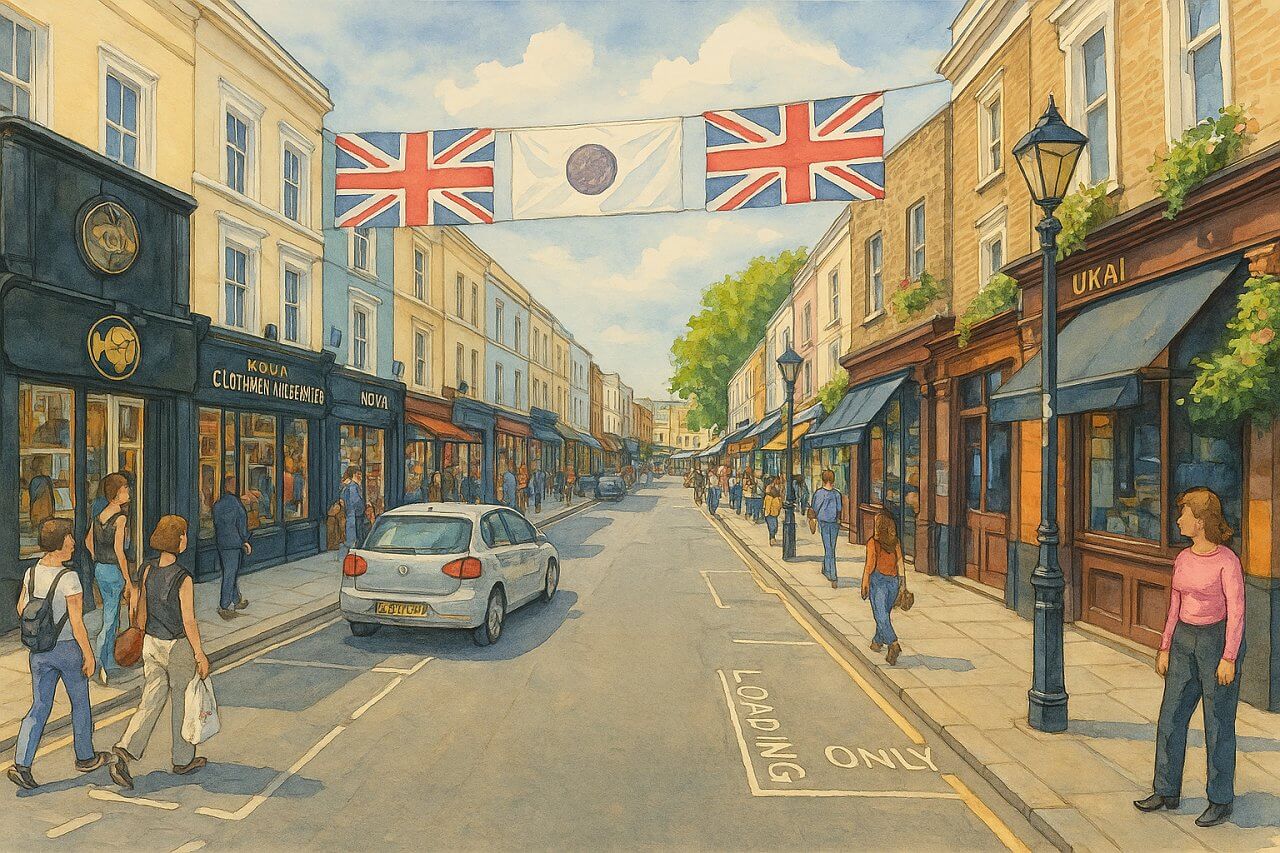
Portobello Road, London
A world-famous street known for its eclectic market, historic charm, and colourful houses, Portobello Road is one of Londonís most iconic destinations.
Portobello Road is located in the City of Westminster and Royal Borough of Kensington and Chelsea, in west London. It runs roughly north to south, cutting through the vibrant neighbourhood of Notting Hill. It begins near Kensal Green in the north and runs south to Notting Hill Gate, intersecting with streets like Golborne Road, Westbourne Park Road, and Pembridge Road.
Portobello Road sits within postal districts W10 and W11. While it is often associated with Notting Hill, parts of the street lie just within the boundaries of Westminster, particularly around its northern tip.
Length and Layout
The total length of Portobello Road is approximately 1.9 kilometres (1.2 miles). It winds through a mixture of residential areas, antique shops, independent cafés, and open-air markets, making it one of the most diverse and walkable streets in west London.
A Brief History of Portobello Road
Portobello Road’s roots trace back to the 18th century. In those days, it was little more than a country lane known as Green’s Lane, connecting the Kensington Gravel Pits with the village of Kensal. It was surrounded by farmland and woodland, offering a rural contrast to the growing metropolis nearby.
The major transformation came in the mid-19th century with the construction of housing developments and railway lines. These changes triggered rapid urbanisation and gave birth to the characterful Victorian streetscapes we see today.
How Did Portobello Road Get Its Name?
Portobello Road takes its name from Portobello Farm, which once stood in the area. The farm, in turn, was named after the Battle of Porto Bello in 1739—a British naval victory against Spain in what is now Panama. The name was first recorded around 1740, shortly after the battle, and gradually became associated with the road as development progressed in the 19th century.
Despite what might appear to be obvious, Portobello Road has no connection to portobello mushroom. The mushroom got its name more recently, in the 1980s and 1990s, as a marketing term in the US and UK, to make the mature version of the common brown mushroom (Agaricus bisporus) sound more appealing.
So in short:
- Portobello Road = named after a farm → named after a battle.
- Portobello mushroom = modern name for a large brown mushroom, entirely unrelated.
The Character of the Street Today
Portobello Road is best known today as a vibrant shopping street and home to the world-renowned Portobello Market. The market began in the 19th century as a fresh food market, but by the 1950s it had become famous for antiques and bric-a-brac.
Today, it offers a dynamic mixture of:
- Antique stalls (especially on Saturdays)
- Vintage clothing shops
- Street food vendors
- Fruit and vegetable stands
- Books, art, and music stalls
The colourful terraced houses and bohemian vibe add to its appeal. The road is also known for seasonal events, street performers, and as a filming location for films such as Notting Hill (1999).
Real Estate and Property Prices
Portobello Road is among the most desirable (and expensive) residential streets in west London. As of April 2025, the average property price along Portobello Road is approximately £1.65 million, compared to the London-wide average of around £740,000.
Properties here range in size and style. A typical one-bedroom flat may offer around 550 sq ft (51 sq m), while larger three-storey terraced houses often provide 1,800 to 2,200 sq ft (167–204 sq m) of living space.
Due to its famous name and lively surroundings, Portobello Road commands a premium, particularly for period properties with preserved facades and proximity to the market area.
Nearest Tube Stations and Transport Links
Portobello Road is well connected by London Underground services. The closest stations are:
- Ladbroke Grove Station – served by the Circle and Hammersmith & City lines
- Notting Hill Gate Station – served by the Central, Circle, and District lines
- Westbourne Park Station – served by the Circle and Hammersmith & City lines
In addition, numerous London bus routes pass nearby, including the 7, 23, 27, 52, and 70.
Fun Fact
Portobello Road is home to the Electric Cinema, one of the oldest working cinemas in the UK. Opened in 1910, it still operates today with leather armchairs and cashmere blankets, offering an old-school cinema experience that matches the vintage charm of the road itself.
Quick Facts
- Location: City of Westminster and Royal Borough of Kensington and Chelsea
- Length: 1.9 km (1.2 miles)
- Historic Name: Originally Green’s Lane
- Current Name Origin: Named after the Battle of Porto Bello (1739)
- Known For: Portobello Market, antiques, fashion, street food
- Property Prices (2025): ~£1.65 million average
- Typical Property Size: 550–2,200 sq ft (51–204 sq m)
- Nearest Tube Stations: Ladbroke Grove, Notting Hill Gate, Westbourne Park
- Underground Lines: Circle, Hammersmith & City, Central, District
- Fun Fact: Home to the historic Electric Cinema (est. 1910)
Map of Portobello Road, London

Painting of Portobello Road, London (View image in full size)